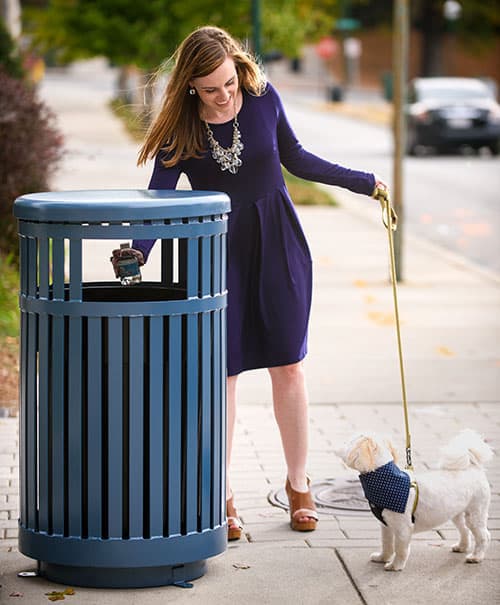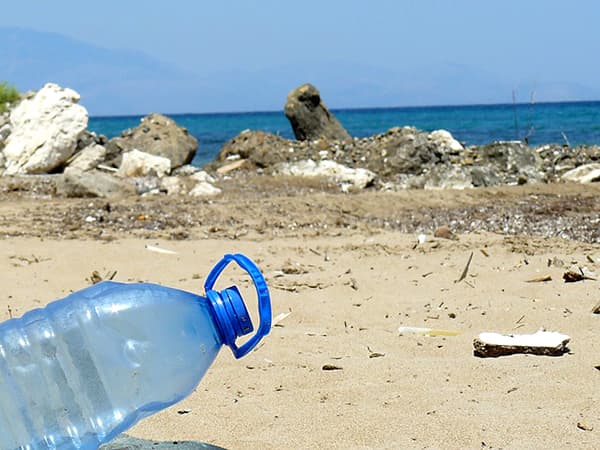Adding more Commercial Trash Cans in strategic locations can help make a dent in the litter that floats down into our storm drains.
More and more photographs of trash, especially plastic debris, floating in rivers, bays, and oceans are becoming more prevalent.
All that litter starts somewhere. One key to stopping it is to capture these discarded items in proper trash receptacles, ash urns or recycling bins.
Here are some interesting findings from a study by Keep America Beautiful about the litter in storm drains.
More Commercial Trash Cans means less trash in storm drains
- Pedestrians create most of the storm drain litter. One might think that people tossing garbage from their cars is the leading source of litter that ends up in storm drains, but according to KAB it's actually pedestrians. They are responsible for an estimated 60% of that litter. This creates a big window for prevention. Provide enough commercial trash cans at key transition points where pedestrians are walking and give them a place to dispose of their litter properly.
- Most of the litter in storm drains is smaller than 4 inches. Much of that litter is discarded cigarette butts. In fact, cigarette waste is the most prevalent form of litter. That's why KAB recommends not only the availability of commercial trash cans but also plenty of cigarette receptacles (also known as ash urns or smokers' outposts).
- Plastics are also very prevalent. One reason is that plastic takes a very long time to deteriorate. Because of this, plastic is a major culprit for contaminating waterway and harming marine life. In fact, Oregon just became the second state to ban plastic straws in most places.
 Commercial trash cans now come in an array of attractive styles and colors
Commercial trash cans now come in an array of attractive styles and colors
Public litter habits are improving
One encouraging note is that in a survey of citizens in 2009 conducted by KAB, only 15% self-reported that they littered in the past month.
Sure, that is still quite a few and you wonder why anybody would litter at all. But at least that 15% was honest.
The good news is, back in 1969, about 50% of those surveyed self-reported that they littered.
What a fantastic improvement in attitudes toward the environment.
Now, many people today might think that older generations are more litter-prone than youngsters.
But according to KAB's research, people under 30 are more likely to litter than the rest of the population. Research shows, the younger they are, the more they litter.
One cause for this might be what is referred to as confection litter - items such as gum or candy wrappers.
Another might be the use of cigarettes.
The lesson here is that if your facility or park has a large number of young visitors, you need to make an extra effort to capture that trash.
Add more commercial trash cans on the premises. KAB research shows that litter tends to start at about 29 feet away from the nearest trash receptacle. So, make sure to close that gap.
Add more cigarette receptacles - discarded cigarettes are still the number one source of trash. These small pieces can do big damage to wildlife.
Add more signage.
Try to make the signage appealing to younger generations.
Try to find a way to instruct younger people on the negative effects of trash on the environment. Show them the trail that trash makes from a park or street into a storm drain and then polluting the very rivers, lakes, and oceans where they like to play.
Adopt some catchy slogan. (Here are several of our favorites).
The "Don't Mess with Texas" campaign to help clean up highways in the Lone Star State was an enormous success. The program was so popular many celebs from Texas pitched in and helped to raise awareness of the effort.
Show youngsters, perhaps with posters, the negative impact on fish, turtles, birds and other wildlife.
Get their peers to promote anti-litter programs. Social pressure is a powerful force when it comes from your own age group.
Attack litter. Aggressively.
 Commercial trash cans - metal, recycled plastic, recycling-oriented, and concrete
Commercial trash cans - metal, recycled plastic, recycling-oriented, and concrete
Overfilled trash receptacles attract more litter
Because here's another finding from the KAB study.
The presence of litter tends to attract even more litter. When people see litter on the ground, many people see that as a green light to dispose of their litter there.
Or, when people see an overfilled trash receptacle, they think it's okay to then leave trash on the ground around it.
Maybe one commercial trash can in that area is not enough. What if there is a special event? Certainly, that warrants the use of additional trash cans. Maybe moveable trash receptacles with wheels or lightweight aluminum commercial trash cans.
Constantly reinforce a mindset in your community to fight litter at all times. The more people who pitch in, the less litter there will be. And as we said, if you don't stop even small instances of litter, the situation can quickly compound out of control.
Litter removal is a significant expense for cities, states, and schools
Picking up all that litter has a cost associated with it as well. When maintenance crews need to spend much of time picking up someone else's trash, that's less time they have to spend on making improvements at parks, say adding more amenities, or other maintenance items like landscaping or painting.
When you consider the size of our population and the number of disposable items we generate, the numbers can be very, very significant.
According to KAB, this is what litter costs each segment EVERY YEAR.
- Municipalities - $797 million (think of all the programs that could provide).
- States - $363 million
- Educational facilities - $240 million (think of all the books that could buy).
- Businesses - $9,128 billion
The thing is, a big portion of that extra expense is something that can be fixed. Just by local residents dropping that hamburger wrapper in commercial trash cans instead of on the ground.
In fact, all those negative aspects of litter - damage to our waterways, harm to wildlife, the presence of rodents, extra costs associated with removing litter and reduction of property prices and business, can easily be avoided.
It just starts with plenty of commercial trash cans in the right places (including ash urns) the right mindset, education and a sustained effort by ALL members of the community.



